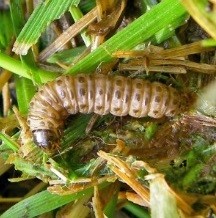Why Should You Eliminate Sod Web Worms from Your Turf?
Sob webworms will attack turfgrasses in Tennessee in spring and early summer. You will notice dead patches of grass throughout your lawn. The damage becomes more severe by midsummer when large sections of the lawn are ruined by the caterpillars. In drought conditions, the damage is worse as the turf is less able to recover from caterpillar feeding. By July and August, when temperatures are highest and cool season grasses are not growing vigorously is when your turf suffers the most. Affected areas recover slowly from webworm feeding, and often are occupied by weeds. If your lawn falls victim to this destructive insect, here is what you can do.
Sod Web Worm Management
 Insecticides
Insecticides
The caterpillars are around 1/4-inch in size. Apply the insecticide of your choice late in the day as possible because these nasty insects are nocturnal. Avoid mowing the area for one or two days after the application.
Biological Methods
There are products that contain Bacillus Thuringiensis Var. Kurstaki, a bacterium which produces a toxin and paralyzes the gut of the caterpillar. This will happen shortly after exposure, so feeding activity slows soon after application.
Another control method is to apply products formulated with Steinernema carpocapsae. This entomopathogenic nematode will seek out caterpillars and penetrate the creature. Once inside the host, it introduces a bacterium which causes a massive infection in the host caterpillar. The nematode then reproduces inside the insect cadaver and moves on in search of new victims, reducing caterpillar populations significantly.
Biological control agent will be only effective if handled properly and applied with adequate water and irrigation.
Should you have an infestation problem, contact Secure Lawn, our experts in grass and pest management will help you control sod webworms, aphids, invasive weeds, among others.


